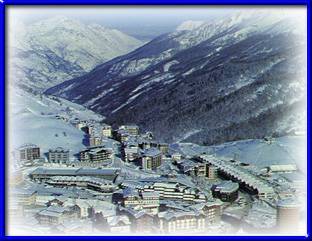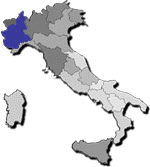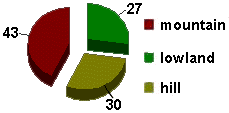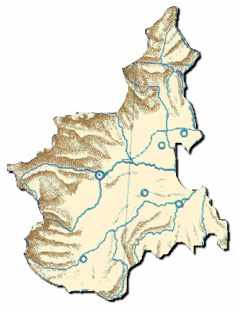Origin of the name:
The Region owes the name that brings to be speaking
geographically to the fact "to the feet of the mountains." In the Middle Ages
it was begun to already call in this way a portion of territory level place to
the feet of the alpine mountains. With the spend some time the same name
remained to point out a vast territory, that is that actual.
| Reliefs - Passes -
Coasts - Islands: |
Piedmont has touched from
Appennino of Liguria, from Alps Marittime, from Alps Cozie that included the
peak of Monviso, from Alps Graie with the Group of Gran Paradiso and of White
Mountain, from Alps Pennine with Cervino and Rosa Mountain and from Alps
Lepontine that are extended in the oriental part of the Piedmont. A group of
low hills are gone down by the Appennino of Liguria toward the north, actually
to Po. They are the Hills of the Langhe rich in orchards, Monferrato rich in
vineyards and the hills of Torino.
To see from the lowland, the alpine wall that mends the region seems
unapproachable and insuperable; then passing for the narrow gullies arrives
each other actually to the footsteps, or crosses that the Piedmont and France
connect.
|

Panorama of the city of torino
with the background of the alpi
|
The principal passes are: Hill of Tenda that connects
Cuneo to Nice, Hill of the Maddalena that connects Valley of Stura with Valley
of Rodano, the footsteps of Monginevro, of Frejus and of Moncenisio by which
pass important railway and road lines. On Swiss side there is Footstep of
Sempione that connects Piedmont with north-western Europe. We also find some
footsteps of appenni, that are: Hill of Cadibona, Footstep of Turchino, and
Pass of Giovi. In Piedmont we find the western part of the lowland Padana (‘the
valley of the Po '), that is extended on the left shore of Po. The most fertile
zone in the Piedmontese lowland is that adjacent to Po and low lowland is said,
while the tall lowland that is inclusive between Alps and the hilly zone is
being that less fertile and more arid because of the impermeability of the
ground.
Landscape:
The region is inside and it is not bathed from
the sea. The Alps Marittime, Cozie, Graie, Pennine and those Lepontines, mend
the region from the perturbations of the north Europe; without a gradual hilly
zone, finds the Piedmontese lowlands, where being cultivated to rice mostly
cover as a mirror of water this territory. The hills are very undulated and
small villages, farms, old castles and plantations of fruit trees and vineyards
rise.
Agriculture - Stock-farm -
Rishing:
In Piedmont the most important crop is that of the
rice, of the maize, of the wheat, of some vegetables and of the fruit. The
production of the wine is modest but of quality. We remember some qualities
appreciated of the Piedmontese productions: Barbera, Barbaresco, Barolo,
Nebbiolo, Dolcetto and Grignolino. The abundance of the natural pastures allows
the breeding of livestock, above all cattle. It is produced therefore a
considerable quantity of meat, of butter and of cheese.
| Industry - Tourism: |

Panorama of Sestriere, note place
skiing Piedmontese
|
The most important industry is that auto
(Fiat with the production of motorcars, trailer trucks, trucks, bus, tractors,
airplanes, railway carriages, locomotor), the mechanical industry (machine for
the office, calculators, electronic apparatuses for the computer science), the
chemical industry (rubbers, artificial and synthetic fibers, pharmaceutical
products, alimentary products and vinicoli) and finally the industries of the
cement, of the paper and of the tanning of the skins.
|
Position and Frontier:
The Piedmontese territory includes the inside part of
the western Alps with a line of Appennino and the western part of Lowland
Padana. The confinements with France and Switzerland determine the political
border of Italy. To south it confines with Liguria and to east with Lombardy
and for a brief line with Emilia. To north of the Piedmontese geographical
territory Valley of Aosta is also found, that however it forms a region to
oneself.
Rivers - Lakes:
The Piedmontese rivers are all tributaries of Po and
they have an alpine regime, seen the thin winter and the floods in spring and
summer. This is owed from the reservoirs of the glaciers and from the rains
that in spring, when they start to melt, they go down quickly from the streams
and they meet in the rivers. Po with 652 kms of run is the longest river and
with great course of water, it is born from the Plan of the King from Monviso
and it crosses the whole region. The principal tributaries of left are Dora
Riparia, Stura of Lanzo, Orco, Dora Baltea that goes down from Valley of Aosta,
Sesia, Ticino and Toce that meets its waters in Maggiore Lake. In small number
they are the tributaries of right with Tanaro where Bormida and the Scrivia
meet. All the mountains that surround Piedmont are sprinkled by hundreds of
micro-lakes said alpine lakes. The greatest lakes that Piedmont possesses are
the western shore and the zone north to border with Switzerland of Lake
Maggiore and those of Lake of Orta and the of Viverone.
Climate:
In the alpine zone it is very cold. The climate however
in the lowland is continental, or rather cold winters and often dry, warm
summers, spring and winter rains. There are often formations of fogs as after
all it is characteristic in Lowland Padana. On the shores of the lakes the
climate is mild.
Population:
The population is not distributed so much fairly less
in mountain and in the tall hill. Strong accumulation is found in the big urban
agglomeration in Turin. The industrial development has favored the phenomenon
of the immigration from the other region, in special way from Calabria, Puglia,
Sicily, Marche and Veneto. The same Piedmontese inhabitants left the countries
to move to the centers more industrialized. In many gods abandoned farms took
over immigrated agriculturists, attracted by the mirage of the city.
Communication:
The dense net of communication either traffic road how
railway, has a some European importance for how much it concerns either the
commerce that the tourism. Two railway nets and four highways connect the
region to the rest of Italy and Europe, over that to port of Genoa where many
products are transported by to embark for the international export. The
principal airport is found in Torino (Caselle).
Web Site designed by
MediaSoft - © Copyright 1998-1999 - All rights reserved






